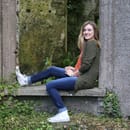Have you ever met someone who has a disadvantage that you would not be aware of unless they told you? In the 7th grade I was diagnosed with something called Nonverbal Learning Disorder or disability (NVLD), a very misunderstood diagnosis. It is often misdiagnosed and like many other diagnoses it differs for each person who has it. You might think that someone with NVLD cannot talk but it is actually the complete opposite. It actually means that there is a discrepancy between my verbal and nonverbal intelligence quotient [IQ]. I have a very high verbal IQ and a low nonverbal IQ. This makes understanding 60% of communication which is nonverbal very difficult. For instance, understanding social cues, sarcasm, and spatial concepts is more difficult.
When talking to me you would think that I am just like anybody else, and that is true for many other learning differences and mental illnesses. But for me the real struggle is feeling like I am blind to a whole other side of communication. It’s there, yet I am not processing or recognizing much of the nonverbal information I am given. As someone who lives with this condition I find it interesting that is still not part of the Diagnostic and Statistical Manual of Mental Disorders (DSM). Many people think that NVLD is part of Autism Spectrum Disorder (ASD), or high functioning autism, and as someone who lives with it I do not find that to be true. I find that there are distinct differences between the two even if I do not possess every symptom of NVLD. I find that the two are separate entities and diagnoses and should be treated as such.
The reason for so many misdiagnoses of Attention Deficit Disorder (ADD) or Obsessive-Compulsive Disorder (OCD) when it really was NVLD stems from the fact that it only came about in the 1970s and still is not very well known. Some of the studies done on it are so interesting and I think it’s amazing how useful brain imaging can be nowadays to show us more information about things like NVLD.
NVLD has made me feel anxious, ashamed, misunderstood, and absolutely terrible about myself, but now I have come to the point over the past year or so where I am beginning to fully accept it as part of my identity. For me, NVLD manifests by: mixing up my left and right, not comprehending sarcasm—I literally take almost everything seriously, making mathematical concepts harder to understand- sometimes especially correlation or things that require me to visually process something in my mind especially when the left and right become opposite from my hands on paper, and sometimes not being able to recognize or control the modulation of my voice or not even registering the social cues that signal for me to be quiet. Also, learning how to drive was a huge challenge for me. I had private driving lessons for about a year to be able to master spatially staying centered in my lane, not getting stuck in the snow—which actually happened on my first drive with my Dad through the neighborhood and mastering my turns.
When I was first diagnosed with NVLD, my thirteen-year-old self thought that the doctor was accusing me of not having any friends as she explained the diagnosis to me and asked questions. My mom assures me now that this is not what happened, but at the time I bawled my eyes out and said that I had plenty of friends. Making friends was never a problem for me because I am so vocal and outgoing. But that communication that I was missing started to create a problem. I had always seen myself as a floater throughout middle and high school. Always trying to be nice to everyone, close with various people in various friend groups, but never truly a part of only one group. Invited to some things but not others even though the other people who were invited I would consider my friend and hopefully they considered me a friend as well. Sometimes in middle and high school I would isolate myself to avoid social situations, but when I was around people I was always outgoing, I fed off their energy. In many ways I considered myself a floater and sometimes a bit of an outsider.
I consider myself pretty high functioning and in the grand scheme of things I’d say that although NVLD impacts my life I do not feel as if it always affects me. In reality it is always there, in the background, I just sometimes don’t realize what I am missing since nonverbal information does not even register with my brain sometimes. Somehow, I almost can’t imagine what it would be like if I could understand that 60% of communication that I am missing. Funnily enough it is quite ironic that I do have NVLD, a high verbal IQ and low nonverbal IQ because I did not even start talking until I was 2 years old, I even had to go to a speech pathologist. I have always been told that once I started talking I never stopped. And it really is true because I have been so reliant on verbal communication my whole life just to compensate for nonverbal communication.
This is only part of my story and I am beginning to truly take ownership of it. I do not think that I should be seen or treated any differently because of this but often times it is invisible to others unless I tell them. Again, this just goes to show that you never know what anyone is going through and we really should be respectful of everyone. Part of life is obstacles, no matter who you are they exist, this is just one of mine and I am not afraid to share it.


